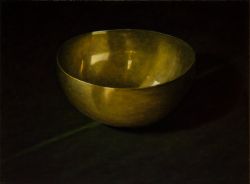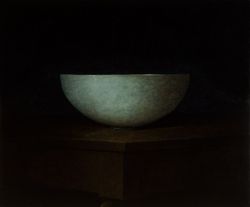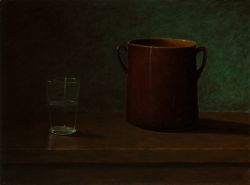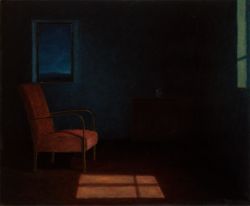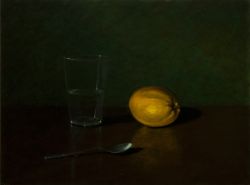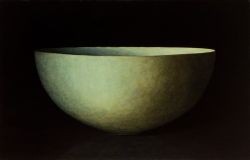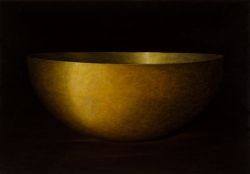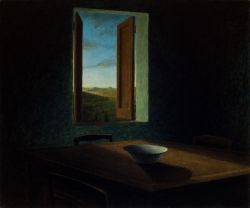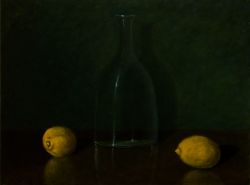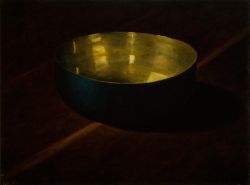Mario Fani
Notturni
11th of November - 2nd February 2018
18 years ago my friend Arnaldo Romani Brizzi introduced me to Mario Fani, a radically “aretino” painter, and I wrote of his works, for an exhibition that at the time was called Conversazioni in un interno, a presentation ‘chased’, in a sort of postface, by a beautiful ( beautiful as always) text by Arnaldo. Our two pieces were in other words an open and closed bracket, like two wings, and in between were Mario’s paintings, and those two wings, I want to express this now that I’m mourning the loss of Arnaldo, were filled with literature, because the relation existing between literature and painting was also this, it moved us and united us, inciting us to polemicize, in our talks, against an extremely invasive and yet illiterate present in art, deprived not only of beauty but also of words, of thoughts.
This is why even now I am not betraying my mandate, and already in the title I reverse the name of a book by Jonathan Franzen, Farther Away, because that which is extremely distant and that which appears most intimately close often have the same nature of remote places, or refuges, of islands. Furthermore something appears to me evident: the place, the house, the rooms of nocturnal visitations, left empty and open until someone should arrive, at an eye's glance are those of many years ago, but it is as if Fani had entered even more, approaching the objects, listening to things. He rests his gaze on them, like one rests one’s ears to the ground. Has he therefore incredibly marked his hunting territory?
It may happen to one seeing a painting rotate, almost as if it were a star, or a planet, the solitude of a cup, of a Tureen, may they be whitened with zinc or porcelain against a blue background, to a gaze that will therefore be filled with this precious emptiness some good preceding example and model and parameter of painting will come to one’s aid. It is inevitable.
Are we at the foundations of art? In the first place with ours. It is so that the “aretino” Fani confronts himself at a distance with the Emilian Morandi, and in a very Tuscan way renders less creamy and waxy, and instead more morphologically intact and hard, structurally almost carved, the poor object, nailed under a gaze that never seems to distract itself, nor desire anything else; object rendered regal, by both painters, during some evening ceremony and without anyone, just like for an investiture, in paintings of domestic devotion, in an impression of rooms and italian shelves kept in good order.
Were we to wander with the mind - because we know, observing a work of art one immediately wanders much, and it is that which occurs in the homeland of arts, one goes here and there following recalls, looking for syntonies, connections, any kind of reverb which may try like this painting is not alone, and by barely brushing against it with one’s gaze rouses an entire chain of recollections and echoes - therefore, I repeat, were we to distance ourselves from here we may be approached by that Marcel Proust that seems to talk of other things, when instead he says: “Here we are at the endpoint of that journey of initiation into the neglected life of inanimate nature that each one of us may make by letting himself be guided by Chardin as Dante let himself be guided of old by Virgil. Chardin taught us that a pear is as much alive as a woman, that a vulgar receptacle is as beautiful as a precious stone. The painter has proclaimed divine equality of all things in front of the soul that contemplates them, in front of the light that adorns them”. After all it is the same things one thinks of every time in front of Morandi’s glasses and bottles, namely of a painter that travelled much on the rail line of French still life that from Chardin leads to Cézanne: they are not simple objects, they are us. Or in any case, they are also us.
Indeed, although with his artworks, with his sustainable and locally sourced paintings, Fani knows how to make silence speak, we notice how he also knows how to stage a whole dynamic of exchanges and communications between things, dialogues that ratify absences and which don’t appear to suffer of our absence, of us humans. It is an interesting perspective vision in a habitat which drowns in selfies, precisely because it is absolutely deprived of vanity. For example, objects express their own in Dissonanze e Duetto, with intimate matches between a wood corner and the curve of a cup, in the first instance, it is between what is glassy, transparent, and in the second, that which remains opaque. Murmurs that arise from the desire to oppose a simple order to the chaos of the world out there. A protection of silence and geometries and tenuous lights. Assume all of this as an antidote, perhaps also not only from an ethical and stylistic point of view, because even we are undoubtedly willing to bargain the fleeting, useless life of many pixels with a well placed paintbrush, with a more made durable coat, “handmade”.
A few years ago I went to Madrid to interview Antonio Lopez Garcia, and when I asked him what he thought was the virtue that all great Spanish artists have in common, he answered like this, and that which he told me I turn to Fani and to those now observing his artworks, because, anyhow in three lines there’s everything: “It is our capacity to observe the real world. Not to dream, but to observe. All the mystery can be found in things. It is through the visible world that the invisible one appears”. And while he spoke, he would turn with his gaze, devotedly pointing out to me once again a reproduction of the Bodegones, the small vases that Zurbaràn painted four centuries ago.
"Closer still", by Marco Di Capua

